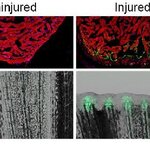Evolution

The (Pre-)Neanderthals were the first, you see:
One early Out-Of-Africa (OoA) wave occurred ~600 kiloyears ago (according to OoA theory that is, but it is still open whether Asian orangutans or African chimps are our forefathers - the genetic closeness between African humans and chimps may come from human-pan interbreeding before the bonobos split from the common chimps). Anyway, according to OoA, population pressure in Africa pushed sub-populations of apes north, where the climate became just about survivable by those apes. In the north, due to the large temperature differences between the…

We know water is essential to life as we know it, but why?
A paper in Proceedings of the National Academy of Sciences provides strongest evidence that proteins--the large and complex molecules that fold into particular shapes to enable biological reactions--can't fold themselves. Rather, the work of folding is done by much smaller water molecules, which surround proteins and push and pull at them to make them fold a certain way in fractions of a second, like scores of tiny origami artists folding a giant sheet of paper at blazingly fast speeds.
Dongping Zhong, leader of the research…

A study of the ancient and modern DNA of the single humped camel or dromedary has shed new light on how its use by human societies has shaped its genetic diversity.
Long-distance and back-and-forth movements in ancient camel caravan routes were important in shaping the species' genetic diversity, finds the paper in Proceedings of the National Academy of Sciences. This makes sense. Over time the animals would have been engineered by merchants using artificial selection to make sure the best for making the trek were breeding.
Single-humped 'Arabian camels', Camelus dromedarius, have been…
Pregnancy sounds like the ultimate form of animal cooperation – mothers share their own bodies to grow and support their children’s prenatal development. But in reality, embryos use every trick in the book to take more than their fair share. Mothers, in turn, marshal their best defensive tactics.
Ultimately, it’s an evolutionary arms race. Offspring continually evolve strategies to steal resources, while mothers evolve strategies to defend their resources. Natural selection will favor embryos that are able to steal resources, but this will impose costs on the mother.
My colleagues and I are…

Some new speculation on animal (metazoan) evolution, suggesting that it was partly mediated through a biochemical oscillator (cycler), named Life's Timekeeper, present in all animal cells. The cycler controls cell maintenance and repair, thereby determining how long cells survive (longevity) and it originated in the single-celled ancestor of all animals, which had very short cell longevity.
Animal evolution progressed by extending cell longevity, and this was mediated by extended cycle time of the oscillator, the authors contend. Multi-celled animals and cell-cell communication systems…

Inside Science -- How can you tell how a creature walked when all that you have is the head?
For many years, scientists looked to the foramen magnum – the large hole at the base of the skull where the brain connects to the spine – to find out. They believed it showed if an early human was a biped that walked on two legs, or a quadruped that walked on four. But a recent study published in the Journal of Human Evolution calls this into question.
"People thought the foramen magnum was related to upright walking because of balance," explained Aidan A. Ruth, a biological anthropologist at Kent…

1) Motivation (insufficient justification): Throughout the world, there is a ‘new enlightenment.’ Maintaining certain illusions has become so demanding and frustrating that increasingly people simply go for the plain truth because whatever else they say would make little difference in the reception. People witness such and thus find new courage to “call a spade a spade” without apologizing, since an apology in today's mainstream irrational discourse is a mere revealing of weakness that invites further attacks. Since science for me is not a career but “higher calling,” I hold the availability…

The fungal pathogen Batrachochrytrium dendrobatridis (Bd), which has been known to cause the disease chytridiomycosis and decimate frog populations for close to half a century, is causing frogs to evolve around it, according to a new study which took a step toward identifying the genetic mechanisms that makes some frogs resistant to Bd infections in their study of lowland leopard frogs in Arizona.
A previous lab study by the same researchers isolated an immune system allele (a variant of a gene) called allele Q that gave frogs immunity to chytridiomycosis, an infectious disease that…

If you trace our evolutionary tree way back to its roots, before the shedding of gills or the development of opposable thumbs, you will likely find a common ancestor with the amazing ability to regenerate lost body parts. Descendants of this creature, including today's salamanders or zebrafish, can still perform the feat, but humans lost much of their regenerative power over millions of years of evolution.
In an effort to understand what was lost, researchers have built a running list of the genes that enable regenerating animals to grow back a severed tail or repair damaged tissues.…

While wheat has been much maligned recently for it's gluten content, and new suspicions casted about as to its nutritional value, scientists have been eager to trace the evolutionary history of wheat to better understand the pasta wheat currently available.
Since the dawn of agriculture, humans have been selecting plants to maximize both the crop yield and food benefits. But which has left the larger genomic footprint, and are there evolutionary tradeoffs with domestication?
In a new study published in the early online edition of Molecular Biology and Evolution, scientists Romina Beleggia,…